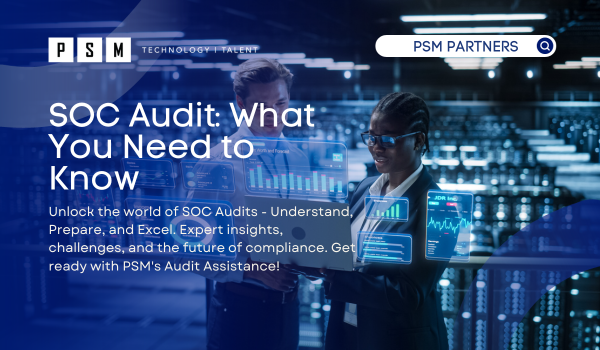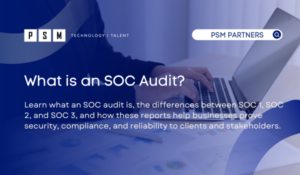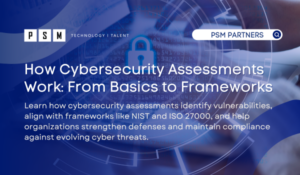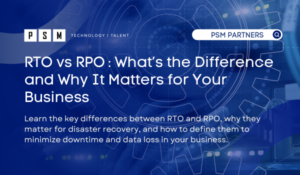Table of Contents
ToggleSystem and Organization Controls (SOC) Audit is a type of audit that evaluates the effectiveness of a company’s internal controls over financial reporting. The audit is conducted by a certified public accountant (CPA) and is designed to provide assurance to stakeholders that the company’s financial statements are accurate and reliable. SOC audits are typically required by companies that provide services to other companies, such as cloud computing providers, data centers, and payment processors.
There are three types of SOC audits: SOC 1, SOC 2, and SOC 3. SOC 1 audits evaluate the effectiveness of a company’s internal controls over financial reporting, while SOC 2 audits evaluate the effectiveness of a company’s internal controls over security, availability, processing integrity, confidentiality, and privacy. SOC 3 audits provide a general overview of a company’s internal controls over security, availability, processing integrity, confidentiality, and privacy, but do not provide as much detail as SOC 2 audits.
SOC audits are becoming increasingly important as more companies rely on third-party service providers to handle their data and financial transactions. By undergoing a SOC audit, companies can provide assurance to their customers that they have effective internal controls in place to protect their data and financial information.
What Is a SOC Audit
A SOC audit is a comprehensive evaluation of a company’s internal control system. It is performed by a certified public accountant (CPA) to ensure that the company’s controls are operating effectively and efficiently. The audit is based on the American Institute of Certified Public Accountants (AICPA) SOC framework, which includes three types of SOC audits.
Types of SOC Audits
The three types of SOC audits are SOC 1, SOC 2, and SOC 3 and each type of SOC audit has a different focus and provides different levels of assurance to stakeholders.
What Is a SOC 1 Audit
SOC 1 audits are focused on a company’s financial reporting controls. They are intended to provide assurance to stakeholders that the company’s financial statements are accurate and complete. SOC 1 reports are typically used by companies that provide services to other companies, such as data centers or payroll processors.
What Is a SOC 2 Audit
SOC 2 audits are focused on a company’s controls related to security, availability, processing integrity, confidentiality, and privacy. They are intended to provide assurance to stakeholders that the company’s systems are secure, available, and processing transactions accurately. SOC 2 reports are typically used by companies that provide cloud computing services, SaaS solutions, or other technology services.
What Is a SOC 3 Audit
SOC 3 audits are similar to SOC 2 audits, but they are intended for public consumption. SOC 3 reports provide a high-level overview of a company’s controls related to security, availability, processing integrity, confidentiality, and privacy. They are intended to be used by companies that want to demonstrate their commitment to security and compliance to their customers and partners.
In summary, SOC audits are an important tool for companies to demonstrate their commitment to security, compliance, and operational excellence. By undergoing a SOC audit, companies can provide assurance to stakeholders that their controls are operating effectively and efficiently.
Importance of SOC Audit
A SOC audit is an important process for any organization that wants to demonstrate its commitment to security and data protection. SOC audits provide an independent assessment of an organization’s controls and procedures related to financial reporting, security, and privacy.
One of the main benefits of a SOC audit is that it provides assurance to customers and stakeholders that an organization is taking the necessary steps to protect their data. This is particularly important for organizations that handle sensitive financial or personal information, such as healthcare providers, financial institutions, and technology companies.
Another benefit of a SOC audit is that it can help organizations identify areas for improvement in their controls and procedures. The audit process involves a thorough review of an organization’s systems and processes, which can uncover weaknesses or inefficiencies that need to be addressed.
In addition, SOC audits can help organizations comply with regulatory requirements. Many industries are subject to regulations that require them to demonstrate compliance with specific security and privacy standards. A SOC audit can provide evidence of compliance, which can help organizations avoid fines and other penalties.
Overall, a SOC audit is an important tool for any organization that wants to demonstrate its commitment to security and data protection. By providing assurance to customers and stakeholders, identifying areas for improvement, and helping organizations comply with regulatory requirements, SOC audits can help organizations build trust and credibility in the marketplace.
SOC Audit Process
Planning
The SOC audit process begins with planning. The auditor needs to understand the organization’s business processes, objectives, and risks. The auditor also needs to understand the scope of the audit, including the systems, processes, and controls that will be evaluated. This information is gathered through interviews, documentation review, and other procedures.
Once the auditor has a good understanding of the organization and the scope of the audit, they will develop an audit plan. The audit plan outlines the audit procedures, timelines, and resources needed to complete the audit. The auditor will work with the organization to ensure the audit plan is feasible and that all necessary information and resources are available.
Execution
Once the audit plan is in place, the auditor will begin executing the audit procedures. This includes testing the controls in place to ensure they are operating effectively. The auditor will also review documentation, such as policies and procedures, to ensure they are up to date and accurately reflect the organization’s processes.
During the execution phase, the auditor may identify issues or weaknesses in the organization’s controls. If this happens, the auditor will work with the organization to develop recommendations for improvement.
Reporting
After the audit procedures are complete, the auditor will prepare a report summarizing the findings. The report will include the scope of the audit, the procedures performed, and the results of the audit. The report will also include any recommendations for improvement.
The organization will have an opportunity to review the report and provide feedback. Once any necessary changes are made, the final report will be issued to the organization.
Overall, the SOC audit process is designed to provide assurance to stakeholders that an organization’s controls are operating effectively. By following a structured process that includes planning, execution, and reporting, auditors can provide valuable insights into an organization’s controls and help identify areas for improvement.
SOC Audit Roles and Responsibilities
In a SOC audit, there are different roles and responsibilities that need to be fulfilled to ensure the audit is conducted effectively. Here are the main roles and responsibilities involved in a SOC audit:
Management
Management is responsible for the overall control environment of the organization. They must ensure that the organization has implemented effective controls to mitigate risks. Management is also responsible for providing the auditor with the necessary information and access to perform the audit.
Auditor
The auditor is responsible for planning, executing, and reporting on the audit. They must have the necessary skills and knowledge to assess the effectiveness of the controls implemented by the organization. The auditor must also ensure that the audit is conducted in accordance with the relevant auditing standards and guidelines.
User Entity
The user entity is the organization that is relying on the SOC report. They must ensure that the SOC report is relevant to their needs and that the controls described in the report are relevant to the services provided by the service organization. The user entity must also ensure that they have the necessary skills and knowledge to understand the SOC report.
Service Organization
The service organization is the organization that is providing the services being audited. They must ensure that they have implemented effective controls to mitigate risks. The service organization must also provide the auditor with the necessary information and access to perform the audit.
In summary, the success of a SOC audit depends on the effective collaboration of all parties involved. Each party has a unique role and responsibility to ensure that the audit is conducted effectively, and that the SOC report is relevant and useful to the user entity.
Benefits of a SOC Audit
A System and Organization Controls (SOC) audit provides several benefits to organizations that undergo the process. Here are some of the advantages of SOC audits:
Enhances trust and credibility
SOC audits are performed by independent third-party auditors who assess an organization’s control environment. The audit provides assurance to stakeholders that the organization has implemented effective controls to safeguard their data and assets. This enhances trust and credibility with customers, investors, and other stakeholders.
Improves risk management
SOC audits identify potential risks and weaknesses in an organization’s control environment. The audit report provides recommendations for improvement, which can help organizations mitigate risks and prevent potential issues from occurring. This helps organizations improve their risk management processes and reduce the likelihood of data breaches or other incidents.
Increases efficiency
SOC audits help organizations streamline their processes and identify areas for improvement. By implementing the recommendations provided in the audit report, organizations can improve their efficiency and effectiveness. This can lead to cost savings and improved performance.
Meets regulatory requirements
SOC audits are often required by regulatory bodies or industry standards. By undergoing a SOC audit, organizations can ensure that they meet the necessary compliance requirements. This can help organizations avoid fines and other penalties for non-compliance.
Overall, SOC audits provide numerous benefits to organizations. They enhance trust and credibility, improve risk management, increase efficiency, and meet regulatory requirements.
Common SOC Audit Challenges
Performing a SOC audit can be a complex and challenging process. Below are some of the common challenges that organizations may face during a SOC audit:
Scope Definition
One of the primary challenges in SOC audits is defining the scope of the audit. Organizations must identify the systems, processes, and controls that are in scope for the audit. This can be difficult, especially for organizations with complex IT environments or those that outsource critical business processes.
Data Availability
Another challenge is ensuring that the necessary data is available for the auditor to perform the audit. This includes both documentation and evidence of controls. Organizations must ensure that they have adequate documentation and that the controls are operating effectively.
Control Design and Operating Effectiveness
Control design and operating effectiveness are two critical areas that are often challenging for organizations. Auditors will assess whether the controls are designed effectively to address the risks identified by the organization. They will also test the operating effectiveness of the controls to ensure that they are working as intended.
Time and Resource Constraints
Finally, time and resource constraints can be a significant challenge for organizations undergoing SOC audits. The audit process can be time-consuming and resource-intensive, requiring significant input from various departments within the organization.
In summary, SOC audits can be challenging for organizations due to the scope definition, data availability, control design, operating effectiveness, and time and resource constraints. Organizations must be prepared to address these challenges to ensure a successful audit.
SOC Audit Compliance
SOC audits are conducted to ensure that an organization’s systems and controls are in compliance with industry standards. These audits are performed by independent third-party auditors who evaluate the effectiveness of the controls in place and provide recommendations for improvement.
To ensure SOC audit compliance, organizations must adhere to the following key principles:
- Policies and Procedures: Organizations must have clearly defined policies and procedures in place to ensure that all employees understand their roles and responsibilities in maintaining the security and integrity of the systems and data.
- Risk Assessment: Organizations must conduct regular risk assessments to identify potential threats and vulnerabilities to their systems and data. This will help them to prioritize their efforts and allocate resources effectively.
- Monitoring and Reporting: Organizations must have systems in place to monitor their networks and systems for suspicious activity and report any incidents to the appropriate authorities.
- Continuous Improvement: Organizations must continuously review and improve their systems and controls to ensure that they remain effective in the face of evolving threats and risks.
By adhering to these principles, organizations can ensure that they are well-prepared for SOC audits and can demonstrate their compliance with industry standards.
Future of SOC Audits
As technology continues to evolve, so does the need for security and compliance. The future of SOC audit is expected to be more focused on technology and automation.
One of the biggest changes expected is the increase in the use of artificial intelligence (AI) and machine learning (ML) in SOC audits. AI and ML can help automate the audit process, making it faster and more accurate. They can also help identify potential security risks and vulnerabilities that may have been missed in manual audits.
Another trend expected in the future of SOC audit is the integration of blockchain technology. Blockchain technology can help improve the security and transparency of audit reports by providing a tamper-proof record of all transactions.
In addition, there is expected to be a shift towards continuous auditing, where audits are conducted on a regular basis rather than just once a year. This can help companies stay on top of their security and compliance requirements and identify potential issues before they become major problems.
Overall, the future of SOC audit looks to be more focused on technology and automation, with an emphasis on improving security and compliance through the use of AI, ML, blockchain, and continuous auditing.
How PSM Can Help You Prepare for a SOC Audit
The journey to compliance can be filled with unforeseen challenges. Why navigate the maze alone? With our seasoned cybersecurity experts by your side, ensure every checkbox is ticked and every standard met, making your audit a seamless experience.
We provide Audit Preparation and Remediation services for businesses of all sizes. Contact us to get audit preparation assistance today!
Related Insights
What is an SOC Audit?
If your organization handles sensitive data or provides services to...
Read MoreHow Cybersecurity Assessments Work: From Basics to Frameworks
Cybersecurity threats are becoming more sophisticated and widespread, putting sensitive...
Read MoreFuture-Proof Your Technology: Why You Should Consider a Computer Upgrade Every 3 Years
Key Takeaways Three-Year Upgrade Cycle Is Ideal Upgrading business computers...
Read MoreRecovery Time Objective (RTO) vs Recovery Point Objective (RPO): What’s the Difference and Why It Matters for Your Business
Key Takeaways RTO Explained RTO (Recovery Time Objective) is how...
Read MoreAbout the Author

Stephen Rosendahl
With over two decades of hands-on experience in cybersecurity, both in the government and the corporate realm, I've navigated the complexities of safeguarding national secrets and driving business cybersecurity objectives. I aim to share my expertise, chronicle my experiences, and offer a unique perspective that blends military precision with corporate innovation. Join me as I delve into the intricacies of cybersecurity, unraveling its nuances and highlighting its paramount importance in today's digital age.





